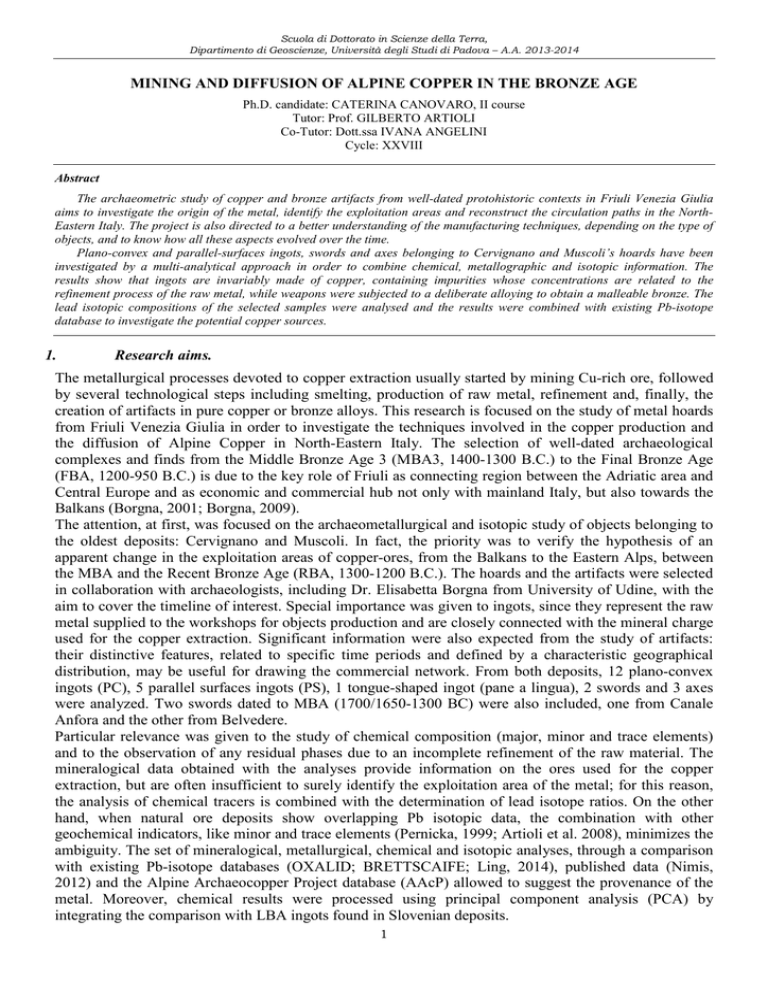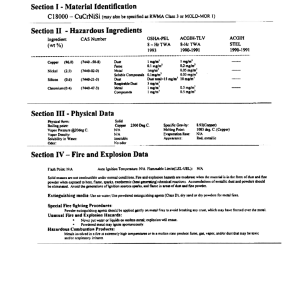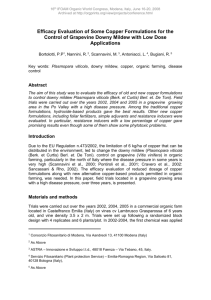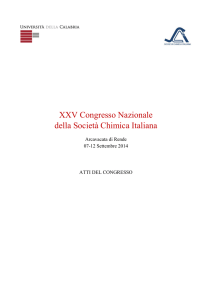Canovaro_Report II anno - Dipartimento di Geoscienze
advertisement

Scuola di Dottorato in Scienze della Terra, Dipartimento di Geoscienze, Università degli Studi di Padova – A.A. 2013-2014 MINING AND DIFFUSION OF ALPINE COPPER IN THE BRONZE AGE Ph.D. candidate: CATERINA CANOVARO, II course Tutor: Prof. GILBERTO ARTIOLI Co-Tutor: Dott.ssa IVANA ANGELINI Cycle: XXVIII Abstract The archaeometric study of copper and bronze artifacts from well-dated protohistoric contexts in Friuli Venezia Giulia aims to investigate the origin of the metal, identify the exploitation areas and reconstruct the circulation paths in the NorthEastern Italy. The project is also directed to a better understanding of the manufacturing techniques, depending on the type of objects, and to know how all these aspects evolved over the time. Plano-convex and parallel-surfaces ingots, swords and axes belonging to Cervignano and Muscoli’s hoards have been investigated by a multi-analytical approach in order to combine chemical, metallographic and isotopic information. The results show that ingots are invariably made of copper, containing impurities whose concentrations are related to the refinement process of the raw metal, while weapons were subjected to a deliberate alloying to obtain a malleable bronze. The lead isotopic compositions of the selected samples were analysed and the results were combined with existing Pb-isotope database to investigate the potential copper sources. 1. Research aims. The metallurgical processes devoted to copper extraction usually started by mining Cu-rich ore, followed by several technological steps including smelting, production of raw metal, refinement and, finally, the creation of artifacts in pure copper or bronze alloys. This research is focused on the study of metal hoards from Friuli Venezia Giulia in order to investigate the techniques involved in the copper production and the diffusion of Alpine Copper in North-Eastern Italy. The selection of well-dated archaeological complexes and finds from the Middle Bronze Age 3 (MBA3, 1400-1300 B.C.) to the Final Bronze Age (FBA, 1200-950 B.C.) is due to the key role of Friuli as connecting region between the Adriatic area and Central Europe and as economic and commercial hub not only with mainland Italy, but also towards the Balkans (Borgna, 2001; Borgna, 2009). The attention, at first, was focused on the archaeometallurgical and isotopic study of objects belonging to the oldest deposits: Cervignano and Muscoli. In fact, the priority was to verify the hypothesis of an apparent change in the exploitation areas of copper-ores, from the Balkans to the Eastern Alps, between the MBA and the Recent Bronze Age (RBA, 1300-1200 B.C.). The hoards and the artifacts were selected in collaboration with archaeologists, including Dr. Elisabetta Borgna from University of Udine, with the aim to cover the timeline of interest. Special importance was given to ingots, since they represent the raw metal supplied to the workshops for objects production and are closely connected with the mineral charge used for the copper extraction. Significant information were also expected from the study of artifacts: their distinctive features, related to specific time periods and defined by a characteristic geographical distribution, may be useful for drawing the commercial network. From both deposits, 12 plano-convex ingots (PC), 5 parallel surfaces ingots (PS), 1 tongue-shaped ingot (pane a lingua), 2 swords and 3 axes were analyzed. Two swords dated to MBA (1700/1650-1300 BC) were also included, one from Canale Anfora and the other from Belvedere. Particular relevance was given to the study of chemical composition (major, minor and trace elements) and to the observation of any residual phases due to an incomplete refinement of the raw material. The mineralogical data obtained with the analyses provide information on the ores used for the copper extraction, but are often insufficient to surely identify the exploitation area of the metal; for this reason, the analysis of chemical tracers is combined with the determination of lead isotope ratios. On the other hand, when natural ore deposits show overlapping Pb isotopic data, the combination with other geochemical indicators, like minor and trace elements (Pernicka, 1999; Artioli et al. 2008), minimizes the ambiguity. The set of mineralogical, metallurgical, chemical and isotopic analyses, through a comparison with existing Pb-isotope databases (OXALID; BRETTSCAIFE; Ling, 2014), published data (Nimis, 2012) and the Alpine Archaeocopper Project database (AAcP) allowed to suggest the provenance of the metal. Moreover, chemical results were processed using principal component analysis (PCA) by integrating the comparison with LBA ingots found in Slovenian deposits. 1 Scuola di Dottorato in Scienze della Terra, Dipartimento di Geoscienze, Università degli Studi di Padova – A.A. 2013-2014 2. Samples and Methods. The survey protocol, developed in previous works to perform an efficient archaeometallurgical study, was divided into different steps. Initially, all the microsamples (0.5-1 mg of fresh metal) – embedded in epoxy resin, ground and properly polished – were examined in reflected light by an optical microscope to survey structural characteristics of the specimens. After coating samples with a thin and uniform layer of graphite, chemical analyses were performed, in first instance, by means of a Scanning Electron Microscope (SEM) equipped with Energy-Dispersive XRay Spectrometer (EDS). The semi-quantitative determination of elements concentration was performed using the standardless ZAF correction, which uses fundamental factors to correct for the effects of atomic number (Z), absorption (A), and fluorescence (F). Then, special attention was given to the detection of minor and trace elements that may be associated to the refining process of the metal, and all samples were subjected to Electron Probe MicroAnalysis (EPMA). The detection limit for this technique is about 0.1% for the suite of investigated elements, except for Pb and Bi (0.25% and 0.9% respectively). Subsequently, all sections were re-polished in order to proceed with the metallographic observations and chemically etched using an alcoholic solution of acidic ferric chloride (FeCl3), as indicated in the literature (Scott, 2011). This technique is directed to identify the production and working technology from microstructural observations and, thus, reconstruct the objects thermo-mechanical history. Finally, the most significant objects were selected for the Pb-isotope analysis. The choice was carried out on the basis of the results provided by the analyses listed above and on the archaeological relevance of the finds. The phase of acid digestion and chromatography of specimens was realized in ultra-clean laboratory of the Department of Geosciences (University of Padova), tested in order to produce reliable isotopic samples (Villa, 2009), while the analysis by mass spectrometry using MC-ICP-MS was performed at the Institut für Geologie (University of Bern). 3. Chemical and microstructural investigations. The compositional data, confirmed by the microstructural observations, indicated an evident distinction between ingots, consisting of copper between 92% and 98% primarily associated to Fe, and objects, bronzes with tin between 10% and 12%. The only exception among the ingots was the tongue-shaped ingot, which was found to be a bronze with a high Sn content (~20%). Focusing on trace elements, the presence of Fe and Zn is related to copper sulphide residues, not completely roasted, and remained in the microstructure as chalcocite (Cu2S) and bornite (Cu, Fe) 2S. In particular, PS-ingots possessed on average Fe and Zn amounts higher than the PC-ingots; this behaviour can lead to suppose that PS-ingots were rougher than PCs due to the lack of the last refining step or for the use of a process less evolved. In any case, the Fe-Zn correlation (coefficient of determination R²=0.93) highlighted the common origin related to the extractive charge, identified as chalcopyrite associated with sphalerite. This evidence is strongly supported by the BSE-SEM observations, which revealed not only the common Fe-zoning in sulphides, but also several Zn-zoning, confirming the presence of sphalerite in the mineral charge. As expected, the objects denoted very low amount of Fe and Zn, indicating a further purification of the metal. Chemical investigations revealed that the objects and the tongue-shaped ingot were characterized by the presence of As and Ni in α-phase, elements not detected in ingots; arsenic is present in different amount (0.1-0.3%), but on average, higher than the As content of the ingots. This aspect has to be considered very interesting, because the smelting process should lead to reduction or elimination of volatile elements, such as As. On the other hand, nickel, was found as a distinguishing element of objects, recorded in the range 0.3-0.6%. Following the concentrations of these two elements and their correlation (R²=0.82), the most plausible hypothesis is that they have been introduced during the alloying, even if they do not manifest any affinity with tin. The only exception is the Canale Anfora’s sword since there were no traces of Ni and As in the alloy. Moreover this sword has a high number of solidification porosity and globular sulphides dispersed within the metal matrix; actually these features are more characteristic of an ingot than of a sword. 2 Scuola di Dottorato in Scienze della Terra, Dipartimento di Geoscienze, Università degli Studi di Padova – A.A. 2013-2014 The huge amount of variables considered in this study was statistically compared to avoid losing precious information. The Principal Component Analysis (PCA) provides a transformation in a linear way of the original variables into new variables in order to describe better the differences and similarities between samples. PCA on ingots and objects (considering Ag, As, Ni, Co, Fe, Zn and Sb) confirmed that PSingots were characterized by a greater number of impurities if compared to PCs. In addition, it was evident a gap between such ingots and the tongue-shaped ingot that better fitted into objects region for the presence of Ni and As. The statistical analysis highlighted that for some Cervignano’s ingots there were traces of Sb, not excluding the possibility of a contamination with little amounts of tetrahedrite. Further, PCA supported the doubts expressed about Canale Anfora’s sword, which set in a borderline region between objects and ingots. Moreover, thanks to chemical data available in literature (Trampuz-Orel et al., 1991), it was possible to compare the plano-convex ingots of Friuli with those from three deposits discovered in Slovenia (Pekel, Hoko Pohorje and Jurka Vas), dated between RBA and FBA (Turk, 1996). The statistical comparison showed that the relative distribution of trace elements in copper was primarily due to the type of raw material employed during the smelting process. For Slovenian samples, characterized by the presence of As, Co, Ni and Sb, it was assumed the use of fahlerz as extractive charge, without apparent similarities with Friuli’s ingots. 4. Isotopic Analyses The samples selected for the isotopic analysis were: 8 ingots (4PCs+4PSs) and the axe belonging to Cervignano’s hoard; 2 swords, 2 axes and 3 ingots from Muscoli’s hoard; the sword of Belvedere and the sword of Canale Anfora. The initial step for the identification of the copper sources is the research, through all ores data, of the ore sample that most closely matches the distinctive values of each artifact. This is done mathematically using a Euclid test procedure. The results demonstrated that the Pb isotope composition of artifacts is considerably different from those of copper ores from the Balkan region (Romania, Serbia and Bulgaria) and Central Europe (Slovakia, Erzebirge, Bohemia). A slight overlap with data of the Austrian ores is evidenced for some Cervignano samples, but the fahlerz mineralization attested for the Carinthia region are not compatible with the extractive charge used for these ingots. More interesting is the matching between artifacts and ores data from the eastern Southern Alps (Fig.1 ab). The comparison shows a good overlap, particularly evident in the 206/204Pb vs 208/204Pb representation (Fig.1b). A detailed investigation lead to the conclusion that 3 ingots of Cervignano have a signal consistent with the copper ores from Calceranica/Vetriolo, while the other 5 ingots, the axe from Cervignano and the sword from Canale Anfora show a distribution consistent with a mixing of copper from Calceranica/Vetriolo and from other mines located in the Veneto-Trentino-Alto Adige region. Conversely, the copper of ingots and weapons belonging to Muscoli hoard come from a restricted area of the Veneto-Trentino-Alto Adige regions. Unfortunately, in literature there is a lack of isotopic data related to Slovenian copper-ores. Fig1 a-.b. Pb-isotope plot of all analysed artefact of Muscoli and Cervignano hoards and Cu-ores from the eastern Southern Alps. 3 Scuola di Dottorato in Scienze della Terra, Dipartimento di Geoscienze, Università degli Studi di Padova – A.A. 2013-2014 5. Metallographic observations The metallographic characterization revealed that axes and swords undergone extensive plastic deformation followed by annealing cycles. Most of the samples taken from the edge blade are still in a strain-hardened state, since several slip lines were observed within grains (crystals), according with the functional use of the weapons that need hard cutting edges. The only exception is a Muscoli’s sword, which shows exclusively twinned grains. However this structure is compatible with the sampled area in the central part of the blade. Therefore, the analyses suggest that only the outer blade was finished by hammering. All ingots show a dendritic microstructure, not deformed, as expected by the cooling after the cast process. This microstructure is also evident in Canale Anfora’s sword, further confirmation of the raw nature of this artifact. 6. Plan for third year In the third year the work will be completed by chemical and metallographic analyses of other artifacts from the hoards of Castions di Strada, Celò, Galleriano and Porpetto dated to LBA and that have been sampled this year. According to the described methodology, each sample will undergo chemical, microstructural, metallurgical and isotopic characterization. Priority will be given to the pick-ingots, particularly interesting as they were also found in Slovenia (Kanalski Vrh), as well as in other areas of the Friuli (Mandriolo) and Tuscany (Grosseto). The characteristic shape of the pick-ingots can give a description of the circulation of the metal during LBA, but also the metal itself can provide useful advices to complete the picture, improving the knowledge of the exploitation areas of Cu-rich ores. References BORGNA E. 2001. I ripostigli del Friuli: proposta di seriazione cronologica e di interpretazione funzionale, Rivista di Scienze Preistoriche, nr. 51, p.289 BORGNA E. 2009. From the Aegean to the Adriatic: Social Organisations, Modes of Exchange and Interaction in the Post-palatial Times (12th-11th BC), ed. Quasar di Severino Tognon S.r.l., Udine. PERNICKA E. 1999. Trace element fingerprinting of ancient copper: a guide to technology or provenance? In: Young S.M.M., Pollard A.M., Budd P., Ixer R.A., Metals in Antiquity. BAR International Series n. 792. Archaeopress, Oxford, UK, p.163 ARTIOLI G., BAUMGARTEN B., MARELLI M., GIUSSANI B., RECCHIA S., NIMIS P., GIUNTI I., ANGELINI I., OMENETTO P., 2008. Chemical and isotopic tracers in Alpine copper deposits: geochemical links between mines and metal, Geo.Alp 5, p.139 OXALID, http://oxalid.arch.ox.ac.uk/ BRETTSCAIFE.net, http://brettscaife.net/lead/data/index.html LING J., STOS-GALE Z., GRANDIN L., BELLSTRÖM K., HJÄRTHNER-HOLDAR E., PERSSON P. 2014. Moving metals II: Provenancing Scandinavian Bronze Age artefacts by lead isotope and elemental analyses, Journal of Archaeological Science, nr. 41, p. 106. Alpine Archaeocopper Project, http://geo.geoscienze.unipd.it/aacp/welcome.html NIMIS P., OMENETTO P, GIUNTI I., ARTIOLI G., ANGELINI I. 2012. Lead isotope systematics in hydrothermal sulphide deposits from the central-eastern Southalpine (northern Italy). Eur.J.Miner.24, p.23. SCOTT D.A. 2011. Ancient Metals: Microstructure and Metallurgy Volume 1. Copper and copper alloys. CSP: Conservation Science Press. VILLA, I. M., 2009. Lead isotopic measurements in archaeological objects. Archaeological and Anthropological Sciences, 1(3), p.149. TRAMPUZ-OREL N., MILIC Z., HUDNIK V., OREL B. 1991. Inductively coupled plasma-atomic emission spectroscopy analysis of metals from Late Bronze Age hoards in Slovenia, Archaeometry 32, p.26. TURK P. 1996. The Dating of Late Bronze Age Hoards, in B. TERZAN, Hoards and Individual Metal Finds from the Eneolithic and Bronze Ages in Slovenia II, Ljubljana. 4 Scuola di Dottorato in Scienze della Terra, Dipartimento di Geoscienze, Università degli Studi di Padova – A.A. 2013-2014 SUMMARY OF SECOND YEAR ACTIVITY Seminar, schools, workshops and congresses: P. TURK, Seminar on “Nuovi dati sui ripostigli dell’età del Bronzo e del Ferro in Slovenia”, Dip. di Storia e Tutela per i Beni Culturali, Università degli Studi di Udine, 16th May 2014. XLIX Riunione Scientifica dell’Istituto Italiano di Preistoria e Protostoria, Preistoria e Protostoria del Caput Adriae, Udine – Pordenone, 8-12 October 2014. 35° Convegno Nazionale AIM, Associazione Italiana di Metallurgia, Roma 5-7 November 2014. Communications: BORGNA E., CANOVARO C., ANGELINI I., ARTIOLI G., Risorse metallifere e metallurgia dell’età del bronzo nel Caput Adriae, XLIX Riunione Scientifica dell’Istituto Italiano di Preistoria e Protostoria, Preistoria e Protostoria del Caput Adriae, Udine – Pordenone, 8-12 ottobre 2014 CANOVARO C., ANGELINI I., ARTIOLI G., BORGNA E., Analisi chimiche e metallografiche di ripostigli dell’area aquileiese, XLIX Riunione Scientifica dell’Istituto Italiano di Preistoria e Protostoria, Preistoria e Protostoria del Caput Adriae, Udine – Pordenone, 8-12 ottobre 2014 CANOVARO C., ANGELINI I., ARTIOLI G., BORGNA E., Analisi archeometallurgiche di pani e panelle provenienti dai ripostigli di Cervignano e Muscoli (Udine), 35° Convegno Nazionale AIM, Roma 5-7 Novembre 2014. ASOLATI M., BONETTO J CALLIARI I., CANOVARO C., RAMOUS E., Analisi metallografica di monete bronzee tardo imperiali scavate ad Aquileia, 35° Convegno Nazionale AIM, Roma 5-7 Novembre 2014. Publications: ANGELINI I., ARTIOLI G., CANOVARO C., MIRIELLO D., PINGITORE V., RUFFOLO S.A., CAPPA M., CRISCI G.M., 2013, Analisi archeometriche sul Gallo conservato nei Musei Vaticani: un raro esempio di bronzo dorato basso-medievale, in: Il Gallo Vaticano, Bollettino d’Archivio n. 22-23, Museo Storico artistico del tesoro di San Pietro, Edizioni Capitolo Vaticano. GUIDO S., MANTELLA G., GAUVAIN A., ANGELINI I., ARTIOLI G., CANOVARO C., MIRIELLO D., PINGITORE V., RUFFOLO S.A., CAPPA M., CRISCI G.M., 2014, Il Gallo Vaticano una scultura in bronzo dorato tra Medioevo e Rinascimento, Atti del XII Congresso Nazionale IGIIC, Lo Stato dell’Arte 12, Accademia Di Belle Arti di Brera, Milano 2324 Ottobre 2014. CANOVARO C., ANGELINI I., ARTIOLI G., BORGNA E., 2014, Analisi archeometallurgiche di pani e panelle provenienti dai ripostigli di Cervignano e Muscoli (Udine), in Atti del 35° Convegno Nazionale AIM, Roma 5-7 Novembre 2014. CALLIARI I., CANOVARO C., ASOLATI M., SACCOCCI A.,GRAZZI F.,SCHERILLO A. 2013, Orio Malipiero's and Enrico Dandolo's denarii: Surface and bulk characterization, Applied Physics A: Materials Science and Processing, 113 (4), p.1081 CANOVARO C., CALLIARI I., ASOLATI M., GRAZZI F., SCHERILLO A., 2013, Characterization of bronze Roman coins of the fifth century called nummi through different analytical techniques, Applied Physics A: Materials Science and Processing, 113 (4), pp. 1019-1028. Field and experimental activities: Isotopes separation (clean laboratory) and ICP-MC-MS analysis at Institute of Geology in Bern University: 25-27 November 2013, 18 – 20 June 2014 and 25 – 28 September 2014 Other: Tutor Junior (Referent) for GEOLOGICAL SCIENCE’s course, a.a. 2013/2014. 5


